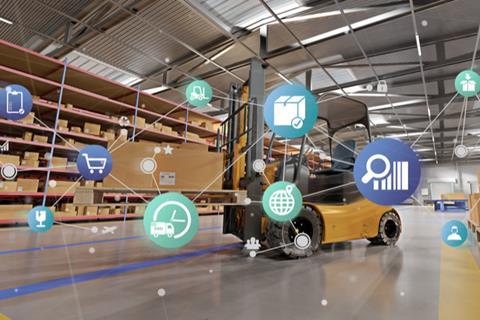The importance of embracing the right tools ÔÇô and knowing what makes a tool right for you ÔÇô canÔÇÖt be overstated, writes Tom Noctor, team lead of strategic product consultants at
You canÔÇÖt always get what you want ÔÇô and sometimes you canÔÇÖt even get what you need.
ThatÔÇÖs become the continual soundtrack of supply chains around the world, and itÔÇÖs set to continue for a while yet ÔÇô creating a ÔÇťshortage economyÔÇŁ.
The construction industry in particular is feeling the strain of this new global trend. It has left the sector struggling with massively inflated materials costs, huge jumps in shipping prices and lengthened lead times. IHS MarkitÔÇÖs latest index found that in the UK alone, . This is the same across the world, with US Bureau of Labor Statistics data showing that the costs for materials and components are increasing at a

With the global economy now structured by shortages, if construction firms want to survive they must manage the risk and instability of supply chains to avoid derailing their projects and their business. They also need to find a way to keep costs down across the rest of their operations to stop increased prices pushing them into the red.
It is no mean feat, but construction has the capacity to evolve and adapt to this challenge. The need for smarter construction, through digital tools, was always there but it has now become essential to surviving and thriving in the shortage economy.
Managing supply chain risk
In the shortage economy, one big issue for construction firms is the fluctuation in delivery dates and the supply chainÔÇÖs lack of predictability. Sudden shortages and last-minute changes threaten to throw a project off course ÔÇô causing costs to spiral.
To avoid this, what is needed is a level of communication across a projectÔÇÖs supply chain that enables full clarity on delivery dates and instant notification of any changes. Empowering project managers with immediate access to information will give them the foundations to build a truly accurate project schedule, manage client expectations around deadlines, and adjust work if a supply problem causes delays.
With so many moving parts in construction, many firms are turning to construction management platforms to connect every member of a supply chain and improve the transparency into their day-to-day operations. Using such platforms makes it far easier to detect and inform others of unexpected delays or shortage issues. Of course, some do a far better job of it than others. But what are the features that make the best stand out? Especially in todayÔÇÖs climate, it is key that construction businesses turn to the platforms prioritising visibility.
Across high-risks projects, where there are so many people wearing different hats, whatÔÇÖs needed is accurate and up-to-date information that is available to all in real-time through a single platform. The benefits of this include increased confidence among stakeholders ÔÇô visibility over a project ensures that your people know and understand exactly what is going on in the work they are responsible for. Visibility also improves decision-making by revealing the complete picture, and it means you can identify potentially costly risks far sooner and better ÔÇô unfortunately there is no undo button in construction.
For building services specialists like , the visibility their platform provides has made a real difference to information-sharing across the supply chain ÔÇô particularly for the high-volume housebuilding clients HBS works with. Thanks to all data being live and accessible any time and anywhere, HBS spends less time chasing the statuses of projects and more time focusing on the job at hand.
ÔÇťWhen we can see what stage any project is at, itÔÇÖs a lot easier to order materials for upcoming plots before itÔÇÖs too late,ÔÇŁ says Charles Bull, operations director at HBS Group Southern. ÔÇťItÔÇÖs far too easy for this to become a bottleneck, with subcontractors only ordering the materials they require when they actually need them. This issue has been exacerbated by the effects of covid-19 and Brexit on our supply chain. We are experiencing volatility in the merchantsÔÇÖ stock levels and manufacturersÔÇÖ lead times. ItÔÇÖs more important than ever to be able to forecast ahead on material requirements.ÔÇŁ
Countering shortages and controlling their impact
Efficiency is crucial in the shortage economy. With price hikes and longer lead times increasing expenses and reducing profits, construction firms need to find a way to recoup costs elsewhere. They can do this by working as productively and efficiently as possible, so that they are not wasting money and resources through sluggish or outdated processes.
Again, tech can help here. Construction management platforms allow teams to work more efficiently and make administrative tasks easier with readymade templates, fast-tracked invoicing processes, and features to monitor tender progress and success. And not only do these tools help teams work more efficiently in the moment, they generate data that enables managers to identify any bottlenecks or problem areas affecting the business.
There are huge efficiency gains to be made from digital platforms, but they donÔÇÖt count for much if ease of use is an issue in the technology you choose. Any procurement process should prioritise finding a platform that is intuitive, easy to adopt, and provides detailed onboarding and ongoing support. Tick these boxes and your solution will sell itself to the people who matter most: the team who need to use it. Without their approval, your technology wonÔÇÖt work as advertised.
The shortage economy may have limited materials and labour but this does not affect our ability to rethink and innovate. Embracing new tools and updating processes allows firms to adapt to new economic conditions and manage the higher risks and costs created by the supply chain crisis. The importance of embracing the right tools ÔÇô and knowing what makes a tool right for you ÔÇô canÔÇÖt be overstated.

























